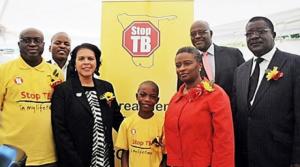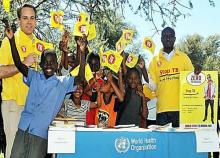Namibia Commemorates World Tuberculosis Day with "Stop TB in my Lifetime"
World Tuberculosis (TB) Day was commemorated on 29 Match 2012 under the theme, “Stop TB in my Lifetime,” with an urgent call for ZERO TB DEATHS. This year’s event had a special focus on Childhood TB towards getting to ZERO.
Globally, half a million children aged 0 to 14 years of age becomes ill with TB each year and as many as 70 000 children die from the disease every year. Despite global and national TB progress it is becoming more apparent that children have been left behind. Childhood TB is a hidden epidemic. That’s why Childhood TB was the focus of this year’s commemoration of World TB Day with the theme “Stop TB in My Lifetime.”
To commemorate this year’s World TB Day, the Ministry Health and Social Services, other line Ministries, and development partners combined edutainment in the form of Flash Mobs across the city, which culminated in the main event at the UN Plaza in Katutura, Windhoek. The commemoration was attended by the Honorable Minister of Health and Social Services, Dr. Richard Kamwi, World Health Organization Representative, Dr Magda Robalo, USAID Ambassador Ms Wanda Nesbit, Khomas Regional Governor, Mr Samual Nuuyoma, representaives of civil society organizations and regional directors among others. The campaign was supported by various celebrities such as Exist & Mushe, who are TB ambassadors, among others, who entertained the crowds.
Addressing the packed audience, Honourable Minister of Health Social Services, Dr Richard Kamwi noted that World TB Day presents an opportunity to take stock of the progress and challenges related to fighting TB. He commended the health sector’s progress towards reducing TB.
“In 2011, there were 11,981 patients diagnosed with TB, compared to 12,625 in 2010. This decline, noted since 2004, is a sign that our efforts are being rewarded. Furthermore, we have also seen a decrease in the number of patients with multi-drug resistant TB (MDR-TB) from 214 in 2010 to 195 in 2011, said Kamwi’. Adding further the Minister encouraged health workers and partners to redouble their efforts to realize a Namibia free from TB.
While Namibia is making progress, childhood TB as in other parts of the world has gained little attention. WHO Representative Dr Magda Robalo in her statement noted that, while TB is curable about half a million children aged 0-14 years fall ill with TB and 64 000 children died from the disease in 2010. Commenting on the reasons for childhood TB to go untreated she cited the following reasons:
We think that TB does not affect children – so we may see it as the flu or some other illness,
The commonly used TB test is not good for screening children for TB;
Children who are in contact with adults TB patients are often not traced nor provided with either preventive or curative treatment.
ENSURING A WORLD FREE OF TB WHERE NO CHILD DIES…
Commenting on the success and outcome of the campaign, Honourable Minister of Health and Social Services Dr Richard Kamwi said, “This year, government with the assistance of the Namibian civil society and development partners will focus on promoting zero TB deaths through information dissemination campaigns and ensuring the well-being of TB patients through monitoring programmes.
World Health Organization (WHO) Representative Dr Magda Robalo stressed that to realize the goal of Zero TB deaths, we need to continue looking for new ways of strengthening our response towards effective TB control through improved integration of TB care in the health systems, improving access and adherence to treatment, fostering stronger partnerships and conducting operational research to ensure more effective and efficient TB care.”
In so doing, the MoHSS in partnership the WHO, I-TECH and KNCV will host a Health Professional Seminar on 17 April 2012, with the aim of strengthening health workers capacity to detect, diagnose and treat childhood TB. This seminar is certified with Health Professionals Council of Namibia (HPCNA) as part of continuing professional development for health workers.
Globally on this occasion, WHO in collaboration with the Stop TB partnership launched an advocacy guideline titled: No More Crying, No More Dying: Towards Zero TB Deaths in Children, aimed at lifting the veil of this hidden epidemic. It focuses on why Childhood TB goes often undiagnosed and simple cost-effective strategies required to save children’s’ lives.”
GETTING TO ZERO THROUGH MEDICAL SCIENCE RESEARCH
While every effort is made to educate the public and improve health worker’s training to diagnose and treat TB, WHO and its partners are searching for more effective ways to end this epidemic for good!
In so doing, an important milestone in modernizing TB control was the WHO Global Tuberculosis Control Report 2011, which for the first time includes biomedical research as a critical component of the global fight against TB. Integrating biomedical research into the framework of global TB control is an essential component of the WHO report as well as other recent strategic documents developed by the TB research community, including An International Roadmap for Tuberculosis Research and the updated Strategic Blueprint for TB vaccines. These collaborative efforts to identify gaps and opportunities in biomedical research are critical for developing new interventions and control strategies.
In their lifetimes, today's children should expect to see a world where no one gets sick with TB.
In their lifetimes, women and men should expect to see a world where no one dies from TB.
Zero deaths from TB - Faster treatment - A quick, cheap, low-tech test - - An effective vaccine - A world free of TB.
This is our HOPE. It can be OUR REALITY. Let’s start NOW
Namibia Commemorates World Tuberculosis Day
01 02 03 04
For more information:
WHO Country Office Namibia,
UN House, 2nd Floor, 38 Stein Street,
Klein Windhoek P.O. Box 3444, Windhoek, Namibia.
Tel: +264 61 255 121
Fax: + 264 61 204 6202
Email: registry [at] na.afro.who.int




